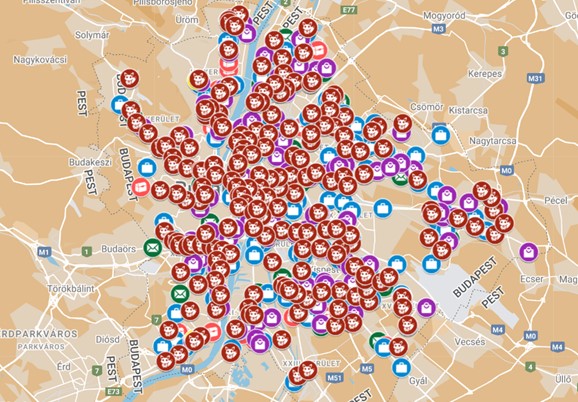Examination of the city logistics system of parcel machines, exploring the related analysis and modeling possibilities
Actual participants of the project: Zalán Uglik (BSc student), Krisztián Bóna (supervisor)
Start of the project: August 2023
In city logistics today, parcel machines are an important new technology that reduces the need for home deliveries. For this reason, the City Logistics Research Group has started to work on this topic, first by exploring the current situation of the parcel machines (parcel lockers) and analyzing their system.
The first step of the research project was to collect data on the providers of parcel machines, using Budapest as an example. This was followed by an analysis of the location of the parcel machines and recording their position on a map. This step was also essential to be able to carry out subsequent analyses not only with distances as the crow flies but also considering different modes of transport, whether walking, cycling, car travel, or public transport.

Parcel machines in Budapest (Autumn 2023)
The exact location of the parcel machines was recorded using the operators’ parcel machine locators, as no database was previously available. The data collected is exported as an XML file to make it easier to manage and perform further calculations. The data set was then analyzed using a novel method of breaking the city down into raster.
The primary objective of this research project was to establish a possible classification system based on the uniform distribution of coordinates within the grid and their relative distance from each other, as well as to analyze the utilization of the parcel machines. Since no official data on the utilization of parcel machines was available, the values used for the indicators were generated by creating a parcel traffic generation model designed for this problem. The approximate values were based on the Hungarian parcel order volumes, the proportion of deliveries to parcel machines, the proportion of parcel machines in the country and the capital, the population distribution in each district, and the number of parcel machine compartments. For the analysis of the latter, a sampling procedure was used, grouped according to three different sizes of compartments, considering the average number of compartments per operator.
The results so far suggest that the parcel machines have been deployed organically, driven by the market so that the area covered by a parcel machine is shared by several operators. The problem is that the calculated utilization is low, so most parcel machines are likely to generate losses and take away valuable resources and space from the city that can be used for other purposes. Accordingly, in the next steps of the research, it will be worthwhile to investigate the city logistics system of the parcel machines further.
Significant documents related to the project
Zalán Tiborc Uglik (Supervisor: Krisztián Bóna). Defining metrics and related indicators to evaluate the spatial properties of parcel locker topologies used in city logistics (2023).
BME Student Research Societies 2023, Logistics section.
URL: https://tdk.bme.hu/conference/KJK/2023/sessions/LOG6/paper/Metrikak-es-kapcsolodo-indikatorok-definialasa
Zalán Tiborc Uglik (Supervisor: Krisztián Bóna). Developing parcel locker networks using consolidation principles (2024).
BME Student Research Societies 2024, Logistics section.
URL: https://tdk.bme.hu/conference/KJK/2024/sessions/LOG/paper/A-csomagautomata-halozatok-fejlesztese